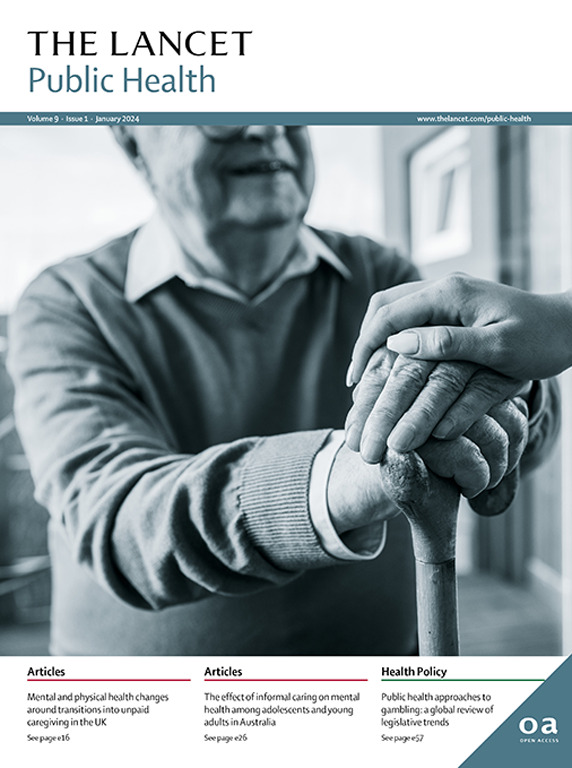Area-level socioeconomic inequalities in mortality in China: a nationwide cohort study based on the ChinaHEART project
IF 25.2
1区 医学
Q1 PUBLIC, ENVIRONMENTAL & OCCUPATIONAL HEALTH
引用次数: 0
Abstract
Background
Socioeconomic status is a key social determinant of health. Compared with individual-level socioeconomic status, the association between area-level socioeconomic status and mortality has not been well investigated in China. We aimed to assess associations between area-level socioeconomic status and all-cause mortality and cause-specific mortality in China, as well as the interplay of area-level and individual-level socioeconomic status on mortality.Methods
In this nationwide cohort study, residents aged 35–75 years from 453 districts and counties were included in the China Health Evaluation and Risk Reduction Through Nationwide Teamwork (ChinaHEART) Study. The composite value of area-level socioeconomic status was generated from national census data and categorised into tertiles. Mortality rates and their 95% CIs were calculated using the Clopper–Pearson method. Cox frailty models were fitted to calculate adjusted hazard ratios and 95% CIs for area-level socioeconomic status with the risk of all-cause mortality and cause-specific mortality and their disparities across different population. We also assessed the roles of multiple individual factors as potential mediators.Findings
Between December, 2015, and December, 2022, 1 119 027 participants were included, for whom the mean age was 56·1 (SD 9·9) years and 672 385 (60·1%) were female. 24 426 (5·24 [95% CI 5·18–5·31] per 1000 person-years) deaths occurred during the median 4·5-year follow-up. Compared with high area-level socioeconomic status, low area-level socioeconomic status was significantly associated with an increased risk of all-cause (hazard ratio 1·11, 95% CI 1·07–1·16), cardiovascular disease (1·38, 1·29–1·48), and respiratory disease (1·44, 1·22–1·71) mortality. The stronger associations were observed in people older than 60 years, females, and participants with lower individual-level socioeconomic status. The individual-level socioeconomic, behavioural, and metabolic factors mediated 39·5% of the association between area-level socioeconomic status and mortality, of which individual-level socioeconomic status made the largest contribution.Interpretation
There are substantial area-level socioeconomic status-related inequalities in mortality in China. Individual-level socioeconomic, behavioural, and metabolic factors had mediating effects. Actions to improve area-level circumstances and individual factors are needed to improve health equity.Funding
The Chinese Academy of Medical Sciences Innovation Fund for Medical Science, the National High Level Hospital Clinical Research Funding, the Ministry of Finance of China, and the National Health Commission of China.Translation
For the Chinese translation of the abstract see Supplementary Materials section.中国死亡率的地区社会经济不平等:基于 ChinaHEART 项目的全国性队列研究
背景社会经济地位是健康的一个重要社会决定因素。与个人层面的社会经济地位相比,中国尚未对地区层面的社会经济地位与死亡率之间的关系进行深入研究。我们旨在评估中国地区级社会经济状况与全因死亡率和特定病因死亡率之间的关系,以及地区级和个体级社会经济状况对死亡率的相互影响。方法在这项全国性队列研究中,中国健康评价与风险降低全国团队合作研究(ChinaHEART)纳入了来自 453 个区县的 35-75 岁居民。根据全国人口普查数据得出地区社会经济地位的综合值,并将其分为三等分。死亡率及其 95% CI 采用 Clopper-Pearson 方法计算。通过拟合 Cox 虚弱模型,计算出地区社会经济地位与全因死亡率和特定病因死亡率的调整危险比和 95% CI,以及不同人群之间的差异。我们还评估了作为潜在中介因素的多种个体因素的作用。研究结果在 2015 年 12 月至 2022 年 12 月期间,共纳入了 1 119 027 名参与者,其中平均年龄为 56-1 (SD 9-9) 岁,女性为 672 385 (60-1%)。在中位 4-5 年的随访期间,死亡人数为 24 426 人(5-24 [95% CI 5-18-5-31]/1000人-年)。与地区社会经济地位高的人群相比,地区社会经济地位低的人群的全因(危险比 1-11,95% CI 1-07-1-16)、心血管疾病(1-38,1-29-1-48)和呼吸系统疾病(1-44,1-22-1-71)死亡风险显著增加。在 60 岁以上人群、女性和个人社会经济地位较低的参与者中观察到的关联性更强。个人层面的社会经济、行为和代谢因素介导了地区层面社会经济状况与死亡率之间39%-5%的关联,其中个人层面社会经济状况的贡献最大。个人层面的社会经济、行为和代谢因素具有中介效应。经费来源中国医学科学院医学科学创新基金、国家高级别医院临床研究基金、中国财政部和中国国家卫生健康委员会。翻译摘要的中文翻译请参见补充材料部分。
本文章由计算机程序翻译,如有差异,请以英文原文为准。
求助全文
约1分钟内获得全文
求助全文
来源期刊

Lancet Public Health
Medicine-Public Health, Environmental and Occupational Health
CiteScore
55.60
自引率
0.80%
发文量
305
审稿时长
8 weeks
期刊介绍:
The Lancet Public Health is committed to tackling the most pressing issues across all aspects of public health. We have a strong commitment to using science to improve health equity and social justice. In line with the values and vision of The Lancet, we take a broad and inclusive approach to public health and are interested in interdisciplinary research.
We publish a range of content types that can advance public health policies and outcomes. These include Articles, Review, Comment, and Correspondence. Learn more about the types of papers we publish.
 求助内容:
求助内容: 应助结果提醒方式:
应助结果提醒方式:


